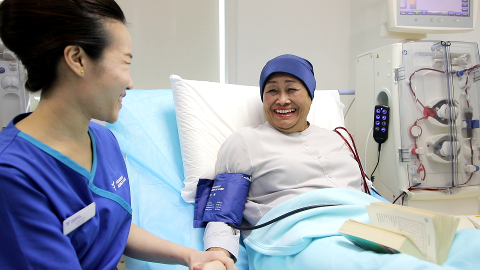
Fresenius Medical Care is dedicated to improving the lives of people undergoing dialysis, as well as supporting those who care for them.

Living with chronic kidney disease
Worldwide more than 3,200,000 patients undergo dialysis because of chronic kidney failure.
Chronic kidney disease can be classified in five stages. The disease can take years to go from below-normal kidney function (CKD stage 1) to chronic kidney failure (CKD stage 5). The chronic form is permanent kidney damage caused, for example, by diabetes, high blood pressure (hypertension), various kidney tissue inflammation (glomerulonephritis) and excessive use of some medications such as painkillers that may reduce long-term kidney function.
The stage of ‘kidney failure’ is reached when both kidneys stop, or have almost stopped doing their normal work (with less than fifteen percent of the kidney's normal functions remaining).
If kidney disease progresses to this stage, waste products from normal body functions and excess fluid (for example, from drinking) accumulate in the body. As a consequence, toxins and water must be removed from the body with a blood purification procedure. This procedure is what's called dialysis.
Chronic kidney failure is treatable. And there are three basic types of treatments available, depending on physical constitution and any underlying diseases: transplantation, hemodialysis, peritoneal dialysis.
![[Translate to English (Singapore):] Kidney dialysis quick facts](/fileadmin/data/masterContent/images/Patients_Families/Understanding_Dialysis/BAS012_dialysis-facts.png)
What is dialysis?
Dialysis replaces some of the functions of the kidneys in patients with chronic kidney failure. Hemodialysis and peritoneal dialysis take over the key tasks of the kidneys, removing waste materials, toxins, excess salt and fluids from the body.
Dialysis treatment does not entirely replace all the functions of the kidneys, meaning that patients almost always need to take certain medications regularly. These include antihypertensive treatments, drugs for lowering phosphate levels in the blood, vitamins and drugs that boost the production of red blood cells to prevent anemia.

Understanding peritoneal dialysis
Peritoneal dialysis treatment is so called, because the blood is filtered in the peritoneum – the membrane that lines abdominal cavity.
The peritoneal cavity stores the dialysis fluid and the filtration takes place across the peritoneum. Toxins and excess fluid cross the peritoneal membrane during the prescribed dwell time.
A permanent tube, or catheter, is inserted into the peritoneal cavity. Through which, dialysis fluid is fed into the cavity and left to absorb the impurities from the blood. Later, the fluid is drained-off into a bag and replaced with fresh fluid.
This process, of filling and draining, can be done manually during the day (Continuous Ambulatory Peritoneal Dialysis, or CAPD). Or done automatically at night with a cycler (Automated Peritoneal Dialysis, or APD). Either way you will need to feel capable and confident to handle the procedure.
Most patients can undergo either hemodialysis or peritoneal dialysis depending on your personal preference to suit your lifestyle unless there are specific medical condition which prevents you from choosing either modality. Peritoneal dialysis is a very smooth process as blood need not come out of the body to be cleaned in a machine.This also give you flexibility and freedom.
There are times when peritoneal dialysis may be the better option. However in many cases, it is a medically-driven choice. For example, if you have some types of heart or vascular disease because of your restricted vascular access. Peritoneal dialysis is usually the treatment choice for young children. Opting for dialysis at home also allows children to continue their schooling.

Family and caregivers
Living with kidney disease is not something you should go through alone. Nevertheless, family dynamics often change when one member has a chronic illness. The people closest to the patient are often emotionally affected, but it doesn’t have to be a negative experience. In fact, living with kidney disease can, and often does, bring the family closer together. Over time family life can reach a new norm, different than before, but just as valid.
There are many people who form part of a support system, from family and friends, to healthcare professionals. Remember, you are not alone. Your social worker can guide, advise and support you in many areas, particularly regarding social services and financial resources.

Understanding Hemodialysis
Hemodialysis is a treatment where blood is filtered outside the body with a dialysis machine. During hemodialysis, blood is drawn off from a blood vessel and passed through a synthetic filter, called a dialyzer. In this dialyzer the blood is cleaned before being returned to the body, therefore, this dialyzer is the so called ‘artificial kidney’.
Hemodialysis is generally performed for at least four hours three times a week, usually in a dialysis unit. An alternative to a clinic based dialysis treatment is being treated in a familiar environment at home. Different types of home dialysis allow patients to adapt their treatment to their everyday routine.
However every type of treatment has its own challenges.
With modern dialysis machines, generally what patients will need is three hemodialysis sessions per week, each lasting a minimum of four hours. During the session, you are connected to the dialysis machine. It’s quite remarkable to consider when you consider that the dialysis machine is trying to achieve in twelve hours’ treatment per week what healthy kidneys do around the clock, every day. By taking the right steps, together we can help you lead as healthy a life as possible.
For in-depth information about Fresenius Medical Care visit the fresenius medical care international website: freseniusmedicalcare.com